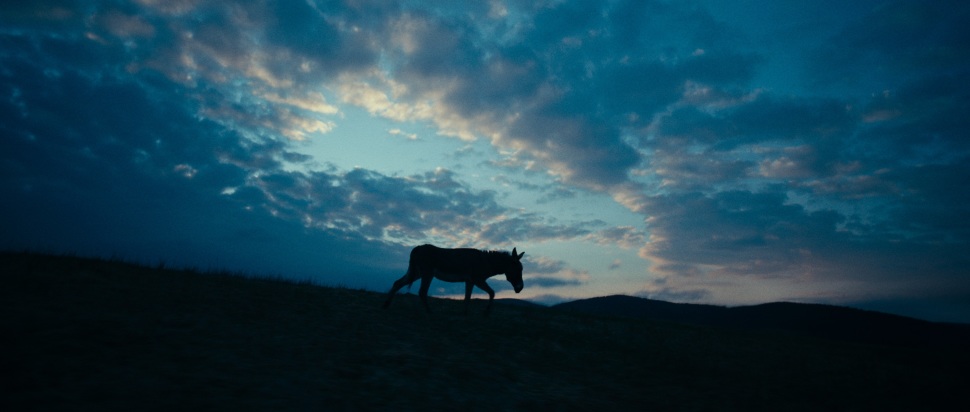Horsin' Around: Jerzy Skolimowski on EO
The great Polish filmmaker Jerzy Skolimowski is back with curious donkey road movie EO. He speaks to us about bonding with his equine actors and creating a film that will leave audiences reconsidering their responsibilities towards their fellow creatures
Donkeys are hot right now. They’ve been all over your cinema screens this award season, from Jenny, the beloved companion of Colin Farrell’s character in The Banshees of Inisherin, to the unfortunate creature who becomes supper to the stranded motley crew in Triangle of Sadness. These are little more than cameos though. This humble creature gets the showcase it deserves in EO. Director Jerzy Skolimowski’s “road movie”, as he calls it, follows the eponymous lovable donkey’s journey as he is whisked across Poland by various human handlers.
The ideas for this tale were twofold, according to Skolimowski: witnessing a “living” nativity show in Sicily at Christmastime, and wanting to eschew a traditional three-act structure in his fourth collaboration with writer and producer Ewa Piaskowska. The latter was intentional, the former an accidental discovery while on holiday. “It was a bizarre event,” he says of that trip to Sicily. “The whole population of this small village was taking part. The final attraction was the barn. We heard a cacophony and saw dozens of different animals – chickens, geese, pigs, cows, and goats – surrounding Joseph, Mary, and the baby Jesus. You couldn’t have a religious atmosphere because of the natural behaviour of the animals.”
In the dark corner of the barn, a donkey stood silently watching. “I noticed those enormous eyes, which have something very specific and melancholic,” he says. “The behaviour of the donkey was entirely different to the excitement of the other animals. He was looking at everything with a distant look of silent witness. I understood that if I used a donkey as my main character, I would create a commentary on what we see.” EO unfolds through establishing shots, then close-ups on the donkey, then another shot of the world from the donkey’s position. “Miraculously, the world looked different,” he says of shots from the animal’s point of view. “It’s a mystery of cinema when you accept that you are looking through the eyes of the animal.”
EO is not played by one donkey but six: Marietta, Tako, Hola, Rocco, Mela, and Ettore. Skolimowski took extra care with this team of non-actors to make sure they were relaxed on set. “They don’t understand what is going on and they don’t understand acting,” he says. “To maintain that naturality they were the kings of the set. Nobody was shouting or making unexpected movements.”
Skolimowski spent all of his free time on set in the donkey’s trailer, providing carrots and conversation. “When you talk to your pets you’re not necessarily making sense; what’s important is the tone of voice,” he says. “I think I managed to create a bond. During shooting I tried to follow the donkey just out of frame, still whispering the same words so they knew it was the same process. We created a special togetherness. We were hunting for the moment we could turn the camera on and register some interesting reaction.”
Showing sequential events that do not necessarily escalate through a traditional narrative from the perspective of a non-human protagonist is key to Skolimowski and Piaskowska’s structure – not only because the dialogue is reduced, he mentions with a laugh. “We made a list of possible events that could happen on such a journey and chose situations which were interesting and, in our opinion, loaded with meaning,” says Skolimowski. A non-traditional narration not only prevented the duo from feeling “like clerks working in the office” but also opened opportunities for figurative storytelling. Many shots from EO’s perspective are filmed in flashing red, and Skolimowski is quick to point out that every situation is fraught with danger from a donkey’s perspective. “He is always being pushed or used by humans except when he escapes and spends the night in the forest” – a sequence rich in greens and blues.
Breaking up the story’s chunks with seemingly unrelated footage – a drone, a skier – allows further creativity and commentary. A robotic dog stumbling across uneven terrain interrupts EO’s closest call. Here, Skolimowski sees the unique, irreplaceable nature of animal life. “I didn’t want to shock the audience, so I used the robot representing the fight for survival,” he says. “Maybe if we mistreat animals so badly, one day we will be without our favourite pets, and then what? Would those robots take the place of our lovely companions in our life? Would that be our future?”
EO’s journey is defined by the people who steer it, and Skolimowski hopes his audience will take away a feeling of responsibility towards their fellow creatures. “The film was made out of love for animals and nature,” he says, hoping it acts as a rallying cry against industrial farming. “Subconsciously, Ewa and I reduced meat consumption during the film,” he says. “Nearly half my crew stopped eating meat completely, and perhaps the audience will ask themselves if they really need bacon every morning.” His dreams for the film’s impact are large, and – with the help of his six stars’ soulful eyes – perhaps in reach. “I hope this film will make a difference,” he says. “I hope a part of the audience will reconsider their attitude towards the world and think what can be changed.”
EO is released 2 Feb by BFI
